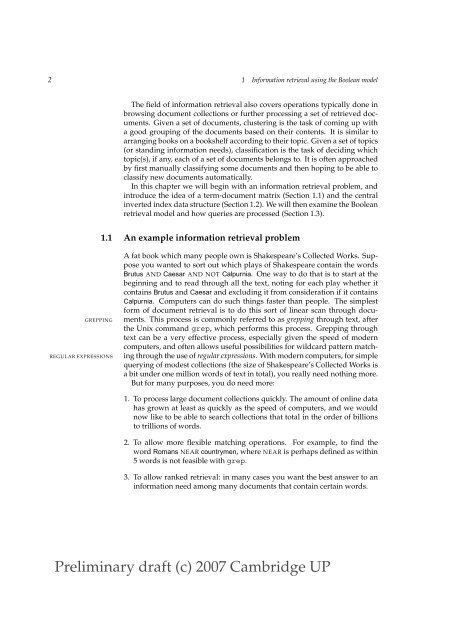Preliminary draft (c) 2007 Cambridge UP - Villanova University
Preliminary draft (c) 2007 Cambridge UP - Villanova University
Preliminary draft (c) 2007 Cambridge UP - Villanova University
You also want an ePaper? Increase the reach of your titles
YUMPU automatically turns print PDFs into web optimized ePapers that Google loves.
2 1 Information retrieval using the Boolean model<br />
The field of information retrieval also covers operations typically done in<br />
browsing document collections or further processing a set of retrieved documents.<br />
Given a set of documents, clustering is the task of coming up with<br />
a good grouping of the documents based on their contents. It is similar to<br />
arranging books on a bookshelf according to their topic. Given a set of topics<br />
(or standing information needs), classification is the task of deciding which<br />
topic(s), if any, each of a set of documents belongs to. It is often approached<br />
by first manually classifying some documents and then hoping to be able to<br />
classify new documents automatically.<br />
In this chapter we will begin with an information retrieval problem, and<br />
introduce the idea of a term-document matrix (Section 1.1) and the central<br />
inverted index data structure (Section 1.2). We will then examine the Boolean<br />
retrieval model and how queries are processed (Section 1.3).<br />
1.1 An example information retrieval problem<br />
GREPPING<br />
REGULAR EXPRESSIONS<br />
A fat book which many people own is Shakespeare’s Collected Works. Suppose<br />
you wanted to sort out which plays of Shakespeare contain the words<br />
Brutus AND Caesar AND NOT Calpurnia. One way to do that is to start at the<br />
beginning and to read through all the text, noting for each play whether it<br />
contains Brutus and Caesar and excluding it from consideration if it contains<br />
Calpurnia. Computers can do such things faster than people. The simplest<br />
form of document retrieval is to do this sort of linear scan through documents.<br />
This process is commonly referred to as grepping through text, after<br />
the Unix command grep, which performs this process. Grepping through<br />
text can be a very effective process, especially given the speed of modern<br />
computers, and often allows useful possibilities for wildcard pattern matching<br />
through the use of regular expressions. With modern computers, for simple<br />
querying of modest collections (the size of Shakespeare’s Collected Works is<br />
a bit under one million words of text in total), you really need nothing more.<br />
But for many purposes, you do need more:<br />
1. To process large document collections quickly. The amount of online data<br />
has grown at least as quickly as the speed of computers, and we would<br />
now like to be able to search collections that total in the order of billions<br />
to trillions of words.<br />
2. To allow more flexible matching operations. For example, to find the<br />
word Romans NEAR countrymen, where NEAR is perhaps defined as within<br />
5 words is not feasible with grep.<br />
3. To allow ranked retrieval: in many cases you want the best answer to an<br />
information need among many documents that contain certain words.<br />
<strong>Preliminary</strong> <strong>draft</strong> (c)<strong>2007</strong> <strong>Cambridge</strong> <strong>UP</strong>



